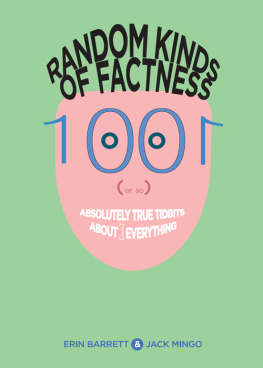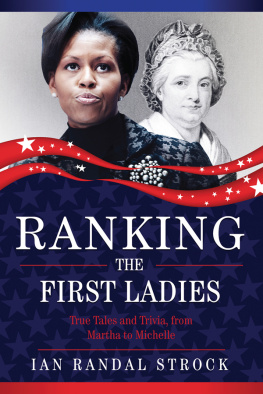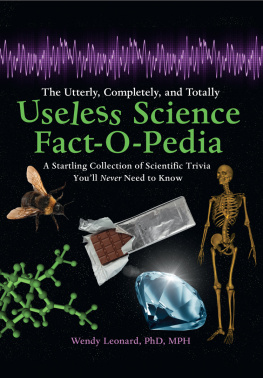
First published in 2005 by Conari Press,
an imprint of Red Wheel/Weiser, LLC
York Beach, ME
With offices at:
368 Congress Street
Boston, MA 02210
www.redwheelweiser.com
Copyright 2005 Erin Barrett and Jack Mingo
All rights reserved. No part of this publication may be reproduced or transmitted in any form or by any means, electronic or mechanical, including photocopying, recording, or by any information storage and retrieval system, without permission in writing from Red Wheel/Weiser, LLC. Reviewers may quote brief passages.
Library of Congress Cataloging-in-Publication Data
Barrett, Erin.
Random kinds of factness : 1001 (or so) absolutely true tidbits about (mostly) everything / Erin Barrett and Jack Mingo.
p. cm.
ISBN 1-57324-212-8 (alk. paper)
1. Curiosities and wonders. I. Title: 1001 (or so) absolutely true tidbits about (mostly) everything. II. Mingo, Jack. III. Title.
AG243.B33 2005
031.02dc22
2005015502
Typeset in Bulmer by Lisa Buckley Design
Printed in the United States of America
VG
12 11 10 09 08 07 06 05
8 7 6 5 4 3 2 1
The paper used in this publication meets the minimum requirements of the American National Standard for Information SciencesPermanence of Paper for Printed Library Materials Z39.48-1992 (R1997).
CONTENTS
PREFACE
Y ou probably already know that reading fun facts can be like eating peanuts (which are neither a pea nor a nut, but a legume). It's hard to stop once you start. You may not know, though, that writing fun facts is likewise addicting. So addicting, that it's hard to stop. In fact, after we started writing them, we eventually found ourselves writing everythingnovels, love letters, even introductions to booksin the funfact style.
We have been writing a daily newspaper column called Random Kinds of Factness for three years now. We know so many components of so many things that we wonder sometimes if we really know anything at all.
Some experts claim that we have more fun facts than any other time of history. However, others argue that the total number of fun facts remains constant year after year.
We know that some fun facts disappear every year. This ever-disappearing nature of individual fun facts is a reason to buy this book and cherish its contents. People like reading fun facts because it makes them feel smart.
Unless you're writing a column or a book, sharing fun facts is not a good way to find companionship at social gatherings. Despite all reasonable expectations, you will not be considered the life of the party, and will likely find yourself alone in a corner, drinking heavily.
People who like reading fun facts are the same people who like that disorienting feeling that comes when their paradigm shifts slightly to the left.
If you learn a lot of fun facts, people no longer invite you to play trivia games. That's partly because you play it so well, but it's also partly because they'll become annoyed when you nitpick the game's facts.
But knowing a lot of fun facts can make you feel smugly superior. Jump into this book and enjoy!
Erin Barrett and Jack Mingo
AMERICANA

B efore it was painted white in 1814, the White House was called "the Presidential Palace."
In the 1950s, nearly 50 percent of American workers were unionized. It was a time of unprecedented gains in wages and benefits. Today, only 15 percent of American workers belong to unions.
Circus fans, do you know how many Ringling Brothers there were? Seven. Al, Gus, Otto, Alf, Charles, John, and Henry. They had a sister, too, named Ida.
How many children did George Washington have? Although he was "Father of His Country," Washington had no biological children of his own.
If you're an average American, you'll spend about a year and a half of your life watching TV commercials.
It's not just a popular stereotype; most barns in the 1800s really were painted red. Why was that? Red paint hid dirt well and was easy to make without having to resort to expensive store-bought paint. Here's the recipe: Mix skim milk with some linseed oil and lime. Add rust that you scraped off some old farm tools for the pigment. Voil!
President John Quincy Adams kept a pet alligator around the White House. He said he enjoyed "the spectacle of guests fleeing from the room in terror."
In Maine, log cabins are exempt from property taxes.
In 1920, the average bill at an everyday diner was 28 cents.

"Kiki" was the childhood nickname of Supreme Court Justice Ruth Bader Ginsberg.
So far, all U.S. presidents have had siblings. Not one has been an only child.
U.S. founding father, George Washington, was a leader in more ways than the obvious. He was first to introduce the mule to America, and he is also considered the Father of the American Foxhound.
The very first American entrepreneur to be worth a billion dollars? Car mogul Henry Ford.
It may be hard to imagine a time when presidents took pride in cultural pursuits, but two presidents actually published books of poetry: John Quincy Adams and Jimmy Carter.
What do you call a president? George Washington wanted to be called "His Mightiness, the President." John Adams preferred "His Highness, the President of the United States and Protector of their Liberties." Neither title caught on. Finally, democratic Thomas Jefferson came up with "Mr. President."
Thomas Jefferson was also the first president to actually shake hands with people. Previous presidents preferred a slight, dignified bow and no body contact.
In the 1880s, about 15 percent of all city dwellers in America had access to an indoor bathroom.
John Breckinridge at thirty-six was the youngest vice president, followed by Richard Nixon, thirty-nine.
Larger than life: The Statue of Liberty is about twenty times bigger than an average American woman. From her toes to the top of her head, she measures a bit over 111 feet.

The term "french fries" was coined by our favorite president Thomas Jefferson. He brought back samples of the fried potato sticks from France and dubbed them "Potatoes fried in the French manner." Americans are an efficient lot, so shortened the name to "french fries."
In the United States, more gold is used to make class rings than any other piece of jewelry.
Benjamin Franklin was the father of the bifocals, the stove, and the Constitution, but did you also know that he was controversial in his time as an advocate of taking baths? Puritans had made bathing illegal on the grounds that nudity of any kindeven in the privacy of your own bathwas a sin. Ben argued that the laws should be repealed. They were, eventually.
Was the Statue of Liberty modeled after a specific person? Two people to be exact. Sculptor Frdric-Auguste Bartholdi used his mother as the model for Liberty's face and his girlfriend as the model for her body. Dr. Freud will see you now, Monsieur Bartholdi.
There's only one crime mentioned by name in the entire U.S. Constitution: treason.
How much does it actually cost to mint our coins? A penny costs about half a cent; a nickel, 2.5 cents; a dime, 1 cent; a quarter 3 cents; and a half-dollar, 5 cents.
Next page












